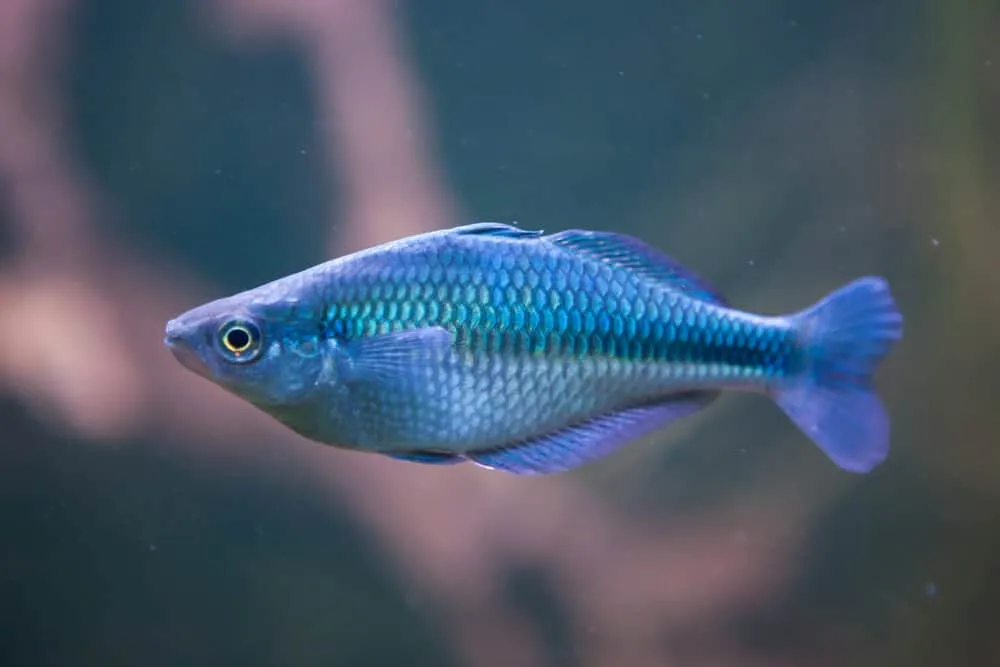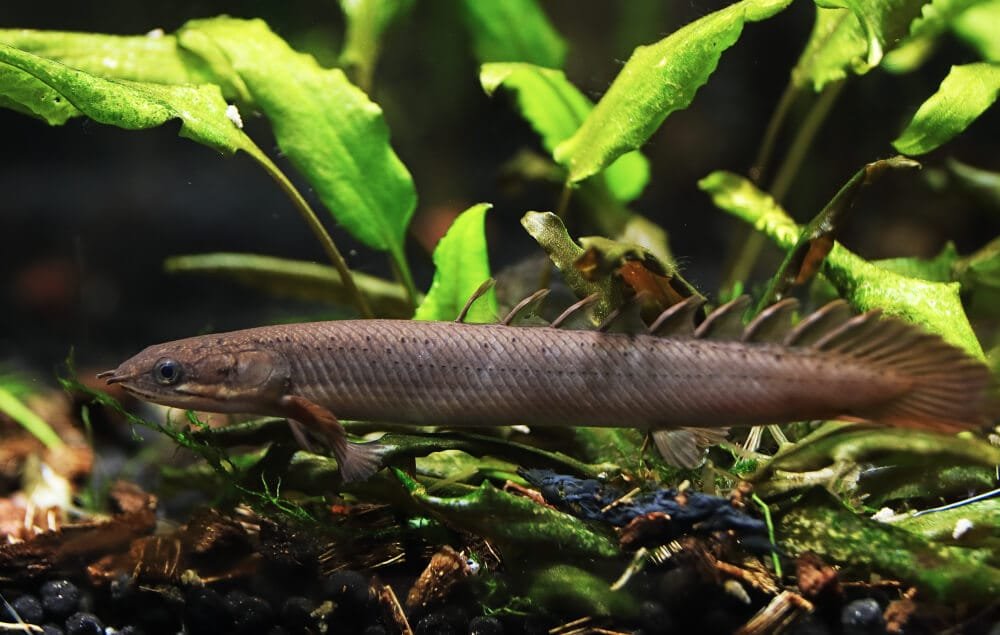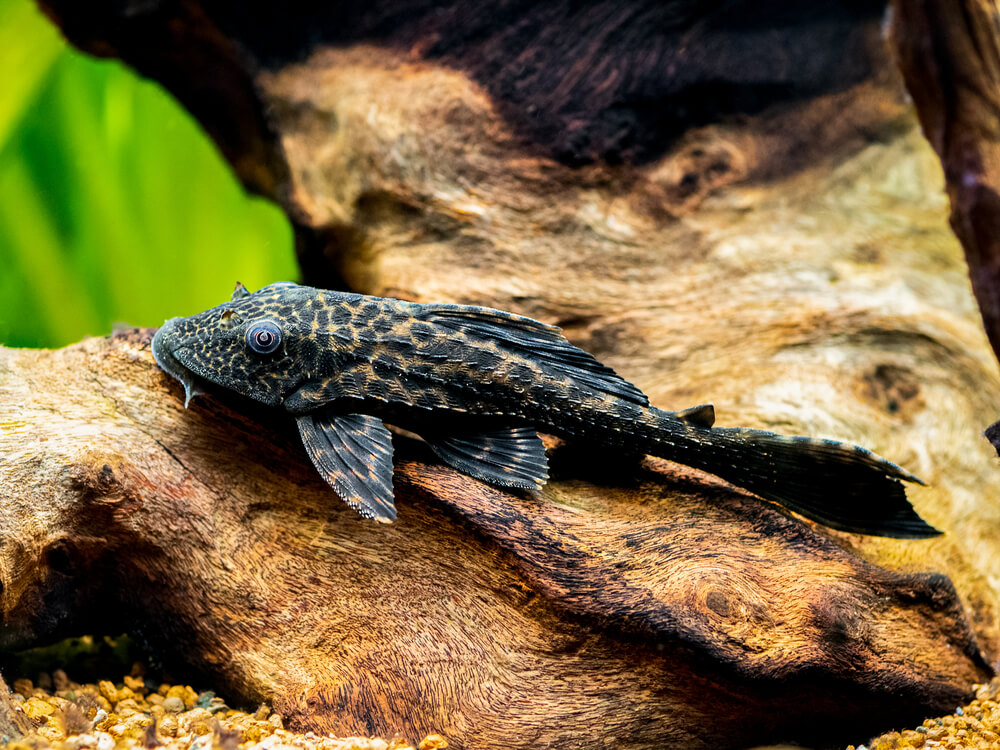Turquoise Rainbow Fish is one of the favorite aquarium pets among the many exotic Rainbowfish. They have a deep blue-green or cobalt blue color on the upper part of the body and gold to silvery white on the lower part.
Both male and female fish of this species have vivid colors. However, mature males develop more striking colors and deeper bodies. The colors make the fish eye-catchy and look bright.
They become more attractive to look at when kept in six or more schools. This is especially true when you keep several males.
The species is a tropical fish that is also called by the name pertaining of its origins, Lake Kutubu Rainbowfish. The other common names of this fish are Blue Rainbowfish and Turquoise Rainbow.
In this article, we will look at everything that pertains to this freshwater fish, including care, diet, breeding, lifespan, and more.
Species Overview
COMMON NAMES: Blue Rainbowfish, Turquoise Rainbow, Lake Kutubu Rainbowfish
SCIENTIFIC NAME: Melanotaenia Lacustris
ADULT SIZE: 4.9 inches
LIFE EXPECTANCY: 5-8 years
Characteristics: Exuberant, playful, but can be aggressive when kept with unsuitable tank mates
Family: Melanotaeniidae
Origin: Lake Kutubu, Papua New Guinea
Social: Peaceful community fish
Tank Level: Middle and upper levels
Minimum Tank Size: 30 gallons
Diet: Omnivore
Breeding: Egglayer
Care: Moderate
pH: 7 to 8.5
Hardness: 8 to 25 dGH
Temperature: 70 to 79 °F
Turquoise Rainbow Fish Overview
Turquoise Rainbow are popular freshwater fish that are prevalent for their striking color and unique body type. The body is long that becomes deeper as they grow older.
They are active fish from Lake Kutubu in Papua New Guinea. This lake connects to River Soro, and both bodies of water are calm.
Aside from being used to calm and clear water, the fish’s natural habitat in Lake Katubu is rich in underground springs’ limestones. The latter gives the water slight alkalinity in its pH level.
It is best to use a darker substrate in the tank to get a better view of the color of the fish. They are versatile, but you have to refrain from placing them in acidic or soft water.
They are generally peaceful. But due to their hyperactivity and size, other timid fish may find them intimidating.
You won’t have a problem with the fish as long as you keep them with other peaceful invertebrates. However, note that the species tend to prey on dwarf shrimp.
Appearance
While the fish are commonly seen in deep dark blue, they can change in various hues. They come in many other colors including blue or a combination of teal and cobalt blue on top. Interestingly, this can fade to give a yellow, silver, or green color at the bottom.
They are capable of changing colors in a flash and can showcase a variety of color patterns throughout the day. Regardless of their color, you will typically see a thin cobalt blue line in their tail’s rear part up to somewhere in the middle of their body.
Among their most distinctive body parts is the head. Mature males will develop a narrower triangular head instead of the usual circular shape that contours with the lines of their bodies.
The eyes are big and impressive and big and catch the attention of most hobbyists. Something else worth noting about this fish species is their dorsal fins, which not only look stunning but also complement the shape, size, and overall appeal of the species.
The fins have a tinge of a slightly bluish hue. You may also likely observe a black color at their fins’ edges, specifically when spawning.
Size And Lifespan
The species have a moderate length and can grow up to 12.47 cm or 4.9 inches. Although it is not known how fast this fish grows, it starts to achieve its color at 6 months. It then attains full size once it reaches one year.
Temperament
The fish are exuberant and have a playful personality. They are generally suited to be kept in community tanks.
However, the IUCN Red List of Threatened Species included them in the Vulnerable category. To keep the species from growing and prevent cross-breeding, they are recommended to be kept in a tank with at least six or more of the same species.
They will thrive well in community tanks due to their social nature. But if you intend to breed them, it is best to comply with the IUCN and keep them in a single-species tank.
The temperament of the fish depends on their companions, especially when they are in a community tank. They can become territorial and aggressive when kept with other species they don’t get along with.
They adapt well in tanks with fish of similar size and temperament. You will know that they don’t like their tankmates when they suddenly become violent and aggressive from being their natural boisterous and active selves.
They are schooling fish that can outgrow common fish in the tank. Their energetic personality can also cause stress to tankmates with the opposite behavior.
The ratio of male and female species in the tank is crucial to sustaining peace among them. If you are to keep a single breed of this species in the tank, ensure that you don’t mix genders if you have five rainbow fish.
However, if you intend to keep more than five, make sure that you add them according to the following ratio:
- Three females and three males if you have six of them
- Four females and three males if you have seven of them
- Five females and three males if you have eight of them
- Five females and four males if you have nine of them
- Five females and five males if you have ten of them
Tank Requirements Of The Turquoise Rainbow Fish
The most important requirement in caring for rainbowfish is maintaining the water’s cleanliness. You need to change 25 to 50 percent of the aquarium’s water once a week.
The higher the water capacity, the higher the percentage of the water you need to replace weekly. Also, proper water maintenance is crucial since they are active swimmers and jumpers.
They are quite energetic, so you have to keep them in a tank that is big enough. You also have to ensure the tank has a cover, so your fish won’t escape and even die from jumping out of the water.
Since they need a constant supply of clean water, it will help to install a filter in the tank. This will help to maintain cleanliness and keep proper and safe water flow all the time. The turquoise Rainbow fish prefers weak to no water movement, just like their natural habitat.
Additionally, to keep this fish happier, you need to decorate its aquarium with bogwood and dense vegetation, as is the case in Papua New Guinea.
They can thrive in alkaline or hard water as long as you put many plants in the tank. Another thing that will help them grow is at least two hours of exposure to the sun each day.
If it’s impossible to move the tank outdoors for a couple of hours each day, just place it near the window. You can put a curtain at the window to block off the sun once the fish have had enough exposure.
Here are the other requirements of the tank you need to follow to provide the fish with a proper environment where they will thrive:
· Tank Size
You can begin with a 30-gallon tank but make it bigger as your fish mature. The size will also depend on the number of fish you’re keeping. If you have 6 to 8 adult Rainbowfish in the tank, its size has to be a minimum of 55 gallons. A 60-gallon tank will also be ideal for schooling fish species.
· Water Hardness
Turquoise Rainbow fish thrives well when kept in water with hardness of around 8 to 25 dGH.
· PH Level
You can keep the pH range of a community tank at 7 to 8.5 to keep the water hard and alkaline.
· Temperature
They like the water at a moderate temperature at around 70 to 79 °F.
· Filter
A filter will help sustain adequate yet soft water movement in the tank.
· Substrate
To make your fish glow in the aquarium, it is recommended to use a dark-colored small sand gravel substrate. You can also add a dark backing to enhance their color and make them stand out. It will also help to add smooth river rocks and some bogwood.
· Plants
They are used to a habitat with dense vegetation. You can add plants to the aquarium but make sure that you leave enough free space for swimming. Choose the plants that can survive the fish’s required water conditions.
· Lighting
They don’t require bright lighting. You can settle for illumination intensity ranging from moderate to normal or just enough for you to monitor them even from afar.
Caring Guide Of Your Blue Rainbow Fish
This fish is easy to care for as long as you keep the water clean. Follow the recommended water changes in the tank once a week.
They hardly get sick. But there are certain diseases they are likely to get when not cared for properly.
You have to regularly clean everything that you add to the tank with this species. They include decors, substrate, plants, and new fish.
Anything you add to the aquarium can cause bacterial buildup. The rainbowfish may get the diseases, but they rarely cause an outbreak in the tank.
More often than not, when they get sick, they only get it for themselves. The only exception is when you allow the tank to get dirty or you don’t feed your fish well.
For the fish to thrive in the tank, you have to give them proper care by taking into consideration the following factors:
Food And Diet
They are omnivores, so they are not difficult to feed. They survive by eating insect larvae, algae, and small crustaceans in their natural habitat.
In the tank, they will readily eat anything you give them, including pellet and flake food. When buying any of these fish foods, ensure that they are high-quality kind to help boost the health of your fish despite being in captivity.
It also helps to add a variety of foods to their diet. For example, boiled and chopped vegetables will make their colors more striking while providing better nutrition.
You must also give them live foods often. This can include bloodworms, tubifex worms, brine shrimp, and other known live fish foods.
While they will often accept high-quality dry foods, it is not recommended to feed them solely with these foods. You have to make their diet more nutritious by supplementing it with live or frozen foods.
Also, keep in mind that the fish have small throats. For his reason, it is recommended to give them food in smaller quantities. When you feed them, give them food they can finish in three to four minutes.
Feed them twice or thrice a day so they won’t get hungry as this can affect their health and behavior.
Breeding
An appropriate tank is required to ensure that breeding your rainbowfish is going to be a success. The tank’s water should be softly acidic to make the environment susceptible to the process.
For this kind of fish species, you need a specific tank to avoid crossbreeding. This way, you can monitor that only the same species of the rainbowfish breed.
Otherwise, there is a high chance that the rainbowfish will breed with other species in the tank. The resulting fish will not have the striking colors that the species are known for.
Set up the breeding tank with a sound filtration system. It is also best to use a sponge filter for this purpose. Make sure that there is plenty of space where they can lay eggs. You can either lay fine-leaved plants, like Java Moss, or keep a spawning mop in the aquarium.
To successfully breed this fish, raise the water temperature to 78 degrees F. In the separate breeding tank, keep about three males and two females of this species.
You have to keep on feeding them healthy nutrition at appropriate times during the day, even while they are in the breeding tank.
The male fish will start changing their colors once they observe that the female fish is showing interest in spawning. The intense coloration of the male fish will allure the female fish to head on to the spawning site.
The female fish will lay the fertilized eggs and the spawning process will continue for several days. As the process continues, the number of eggs hatched will be reduced.
During the process, remove the plants to keep the eggs safe; otherwise, they may become food for the parents. However, you can remove them after the eggs are laid.
After the eggs are laid, use a seeded air sponge filter to remove them from the breeding tank. They will hatch after about ten days.
Ensure that the fries are kept in a tank with favorable conditions. They will begin free swimming 24 hours after hatching.
In the first couple of days after hatching, see to it that you feed and supply the fries with nourishment with foods they can easily consume. You can feed them a sufficient amount of liquid fry food or infusoria.
You can also give them flake food but make sure that you crush them finely before putting them in the tank. Improve their diet for better nutrition after a few more days BY offering them small crustaceans, newly hatched brine shrimp, and live foods.
Tank Mates
Turquoise Rainbowfish are generally peaceful unless paired with tank mates they don’t get along with. To be safe, keep them with fish of the same size and temperament.
They are shoaling fish, so ensure to keep them according to the recommended ratio of male to female fish. They especially do well when kept with other Rainbow fish.
They will likely lose their cool and show signs of aggression when kept aggressive or semi-aggressive fish. You also have to avoid adding fish larger than your rainbowfish.
Additionally, you can’t keep them along with sensitive fish species. They may cause the other fish undue stress as they grow in length.
Here are the highly recommended tankmates for your Blue Rainbowfish:
- Corydoras
- Gobies
- Barbs
- Characins
- Danios
- Other rainbow fish
Diseases
Being a hardy fish species, you will rarely have problems with your fish suffering from diseases provided you keep the tank clean and the parameters suited for their requirements. However, you must be mindful of anything you add to the tank.
Ensure that all elements you add to it are free from anything that may cause bacterial buildup. The main enemy of your pets is bacteria, which can make them weaker and susceptible to diseases common to water creatures.
It will help to quarantine the elements and other fish in a different tank before placing them in the same tank as the Rainbowfish. This is a good way of retaining the balance of the established tank.
Since the fish is known for their resiliency, you need to ensure that they are attended to with haste when they fall sick. You can put the sick fish in quarantine and nurse it back to health. In case of a disease outbreak, the species can contain it to one or a couple of fish and not spread it to the entire tank.
Ensure the fish is happy all the time. This is because the Turquoise Rainbow fish can become susceptible to diseases when stressed. The tank must have similar characteristics to their natural habitat to keep them healthy. You also need to ensure that they are eating the right and balanced diet.
Lifespan
By nature, the Turquoise Rainbow Fish are hardy and live longer than most freshwater fish. The average lifespan of this fish is five years in an aquarium. But many aquarists can prove that they last up to eight years when properly maintained, fed, and cared for.
Interesting Facts About The Species
What else do you need to know about the fish? Here are some interesting facts about this rainbowfish hailing from Lake Kutubu:
· They Are Skilled Jumpers
Never trust a big tank because no matter how high it may seem; they can get past it. That is why it is recommended to place a tight cover over your tank.
· The Male Fish Are More Aggressive
This is why the ratio of the fish in the tank typically requires more females than males. The males are more aggressive but also showcase a more striking coloration.
· The IUCN Lists Them As Vulnerable Species
This species is considered vulnerable and susceptible to manmade activities, such as outboard motors, oil drilling, logging, and gill nets. It also comes as a result of the water movement consistently going up.
· The Species Keep On Decreasing Every Two Years
The water in Lake Kutubu experiences oxygen deficiency every time the water goes up from its bottom areas. Lack of oxygen in the water causes the death of the species in huge numbers.
· They Are Pricey
This fish can be expensive to buy, and this may be due to their rarity and the fact that they are already categorized as Vulnerable. You will likely find them being sold at a higher price than other types of rainbowfish.
Nevertheless, they are readily available in pet stores or you make your purchase online in any online fish store.
Final Thoughts
The Turquoise Rainbow Fish is an attractive species with distinct coloration. They are easy to care for as long as you maintain the tank and feed them right.
They are schooling fish that are not aggressive as long as they are paired with the right tank mates. They will only show aggression when other fish become violent or feel stressed due to inhabitable tank conditions.
It’s an excellent idea to try caring for and breeding the fish. You can start small and begin growing your collection once you have gotten the hang of the proper ways of keeping the species.





